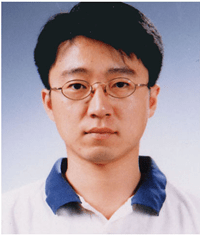
Dong Kwon received the B.S. and M.S. degrees in 1996 and 1998, both from Kyungpook National University, Korea. After coming to Georgia Tech, he joined the Microwave Application Group under the direction of Dr. Joy Laskar. There, he worked on active microwave devices including SiGe heterojunction bipolar transistor based power amplifiers.
Dong Kwon joined the Nano and Ultrafast Photonics Laboratory in 2003 and is conducting PhD research on the use of semiconductor quantum wells for radio-frequency (RF) receivers. The mechanism is to monitor changes in the optical reflectivity of the quantum wells (associated with the quantum-confined Stark effect) induced by the RF field. Applications of such devices include covert monitoring of wireless communications and optically addressed, electrically quiet RF tags. The work proceeds in cooperation with Dr. D. Denison of the Signature Technologies Laboratory of the Georgia Tech Research Institute. In addition, Dong Kwon is working with Prof. Abdallah Ougazzaden of the University of Metz due to the ability to engineer large internal electric fields in wide-bandgap nitride-based quantum wells.
Dong Kwon has carried out theoretical calculations of optical absorption in semiconductor quantum wells with arbitrary band profile in the presence of a growth-direction-oriented electric field. Excitonic effects and valence-band mixing are included in the calculations. By optimizing the composition profile, and thus the band profile, of a quantum well (which typically means a moderately asymmetric quantum well) one can maximize the usable RF-induced alteration of the optical reflectivity. It is estimated that these RF-induced changes can be readily detected using off-the-shelf electronics for the envisaged applications.
Standard RF receivers utilize an RF antenna, whose size is typically on the order of the RF wavelength (centimeters or more). For some applications, however, smaller RF sensors are needed. There have been a few methods explored to move the real-estate intensive part of RF receivers to a remote location by detecting optical changes in a device or material induced by an RF field, but where the optical system used for the interrogation is remote. The approach proposed by us circumvents a number of limitations associated with several other such methods of optical detection of RF signals, such as those based on RF-induced changes in the optical properties of lithium niobate, which requires rather large samples. The approach based on quantum wells, however, requires sensors that can be less than 1 mm in size. In addition, the technique is likely to be applicable up to terahertz frequencies, where based on the group’s prior research experience, it is known the terahertz-induced changes in quantum-well optical properties can be rather pronounced.
Research Interests
- RF modulation of the optical properties of quantum wells
- MQW devices
- Terahertz response of quantum wells
- Integration of microwave and optical devices
Page Last Updated: 20 January 2005

